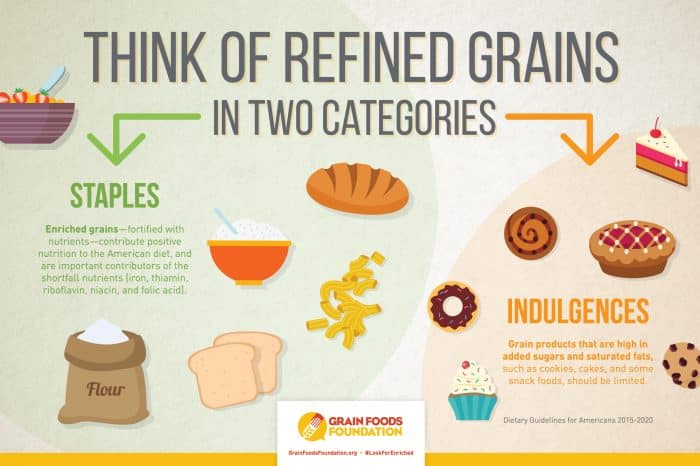What are Refined Grains?
All grains are made up of three parts – the endosperm, bran, and germ. During the milling process, refined grains are made by removing the bran and germ, thereby removing dietary fiber, iron, and many B vitamins. Milling the grain creates a finer texture that is more palatable and extends shelf life – delivering a wide variety of delicious and convenient refined grain products people can enjoy.
While all refined grains go through this milling process, the final products are not necessarily created equal. Among refined grains, staple grain foods and indulgent grain foods are very different.
Staple grain foods are refined grains that are enriched (or fortified) with nutrients, such as iron, thiamin, riboflavin, niacin, and folic acid. In fact, staple grain foods are important contributors of many nutrients most people don’t get enough of each day. Staple grain foods include bread, buns, rolls, bagels, and English muffins, as well as pasta, tortillas, rice, and ready-to-eat cereals. Look for “enriched” or “fortified” on a grain food’s ingredient list to be sure those essential nutrients lost in the milling process have been added to the flour.
Indulgent grain foods tend to be higher in added sugars and saturated fats. These foods include cookies, cakes, and some snack foods, and should be limited and enjoyed in celebrations, cultural foodways, and everyday moments of joy.

Enriched vs. Fortified
To compensate for the loss of the nutrients incurred during the milling process, flour is enriched with key vitamins and minerals. In the United States, approximately 95 percent of all white flour is enriched with iron and four B vitamins – thiamin, niacin, riboflavin, and folic acid – to mimic the nutrients present in whole wheat flour.
Furthermore, the fortification of flour means that additional vitamins and minerals not originally found in the grain are added into flour, and/or nutrients naturally found in the grain are added in amounts larger than their original levels. For example, flour can be fortified with calcium, which is not naturally present in wheat kernels, or fortified with large amounts of folic acid that exceed the amount found naturally in wheat.
Benefits of Staple Grain Foods
Since enriching flour became a requirement in 1941 in the United States, it has aided in the eradication of diseases such as pellagra and beriberi, while also decreasing neural tube defects by 23 percent (as of 2002).
